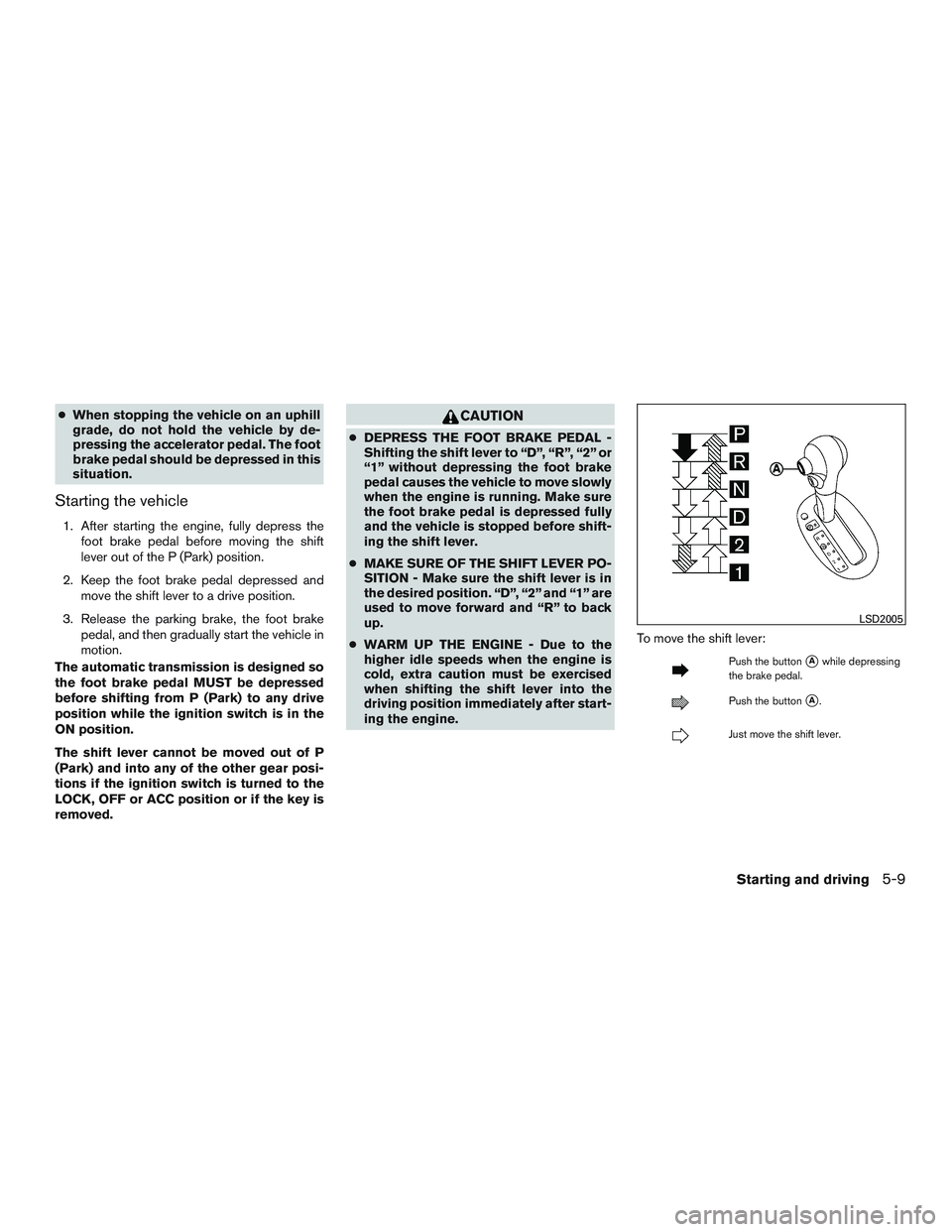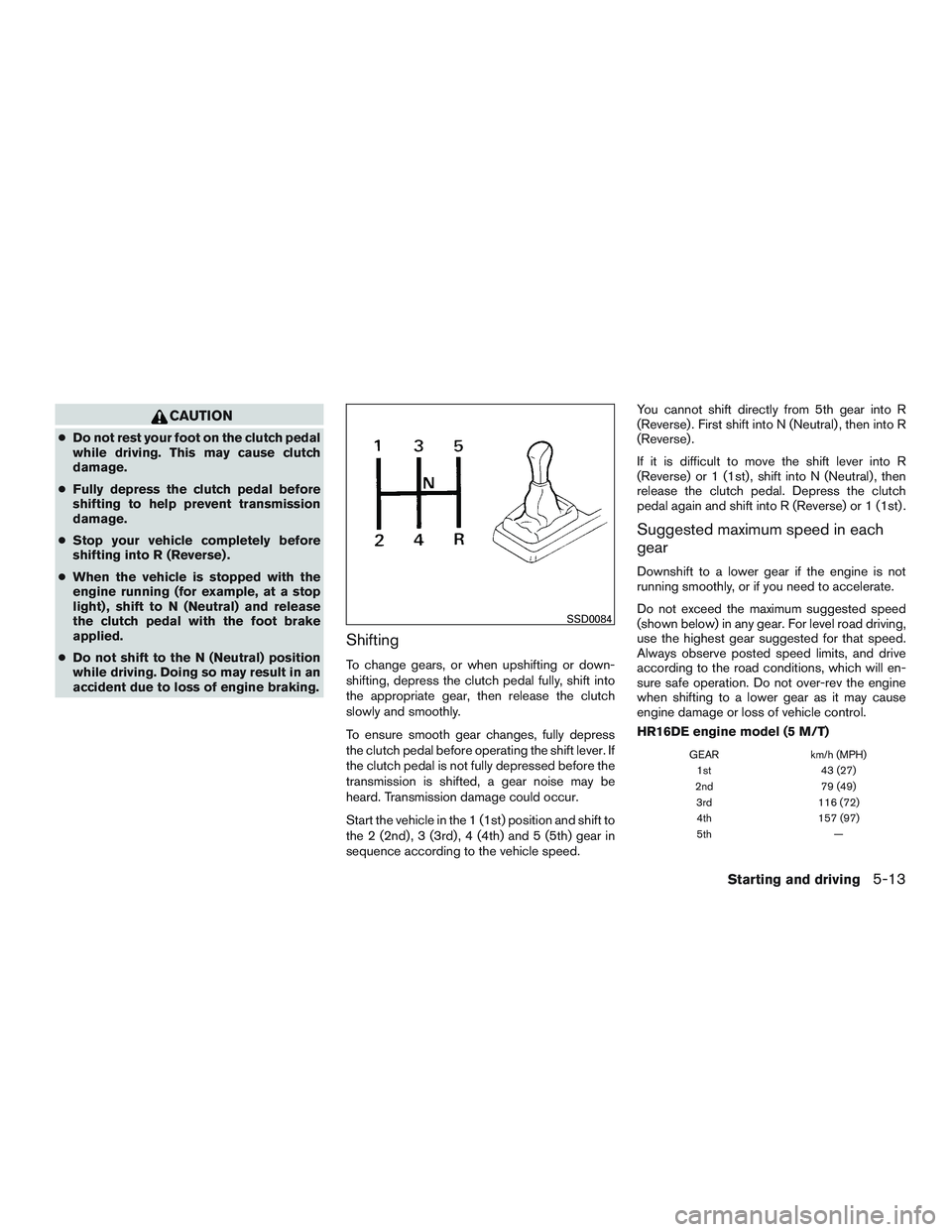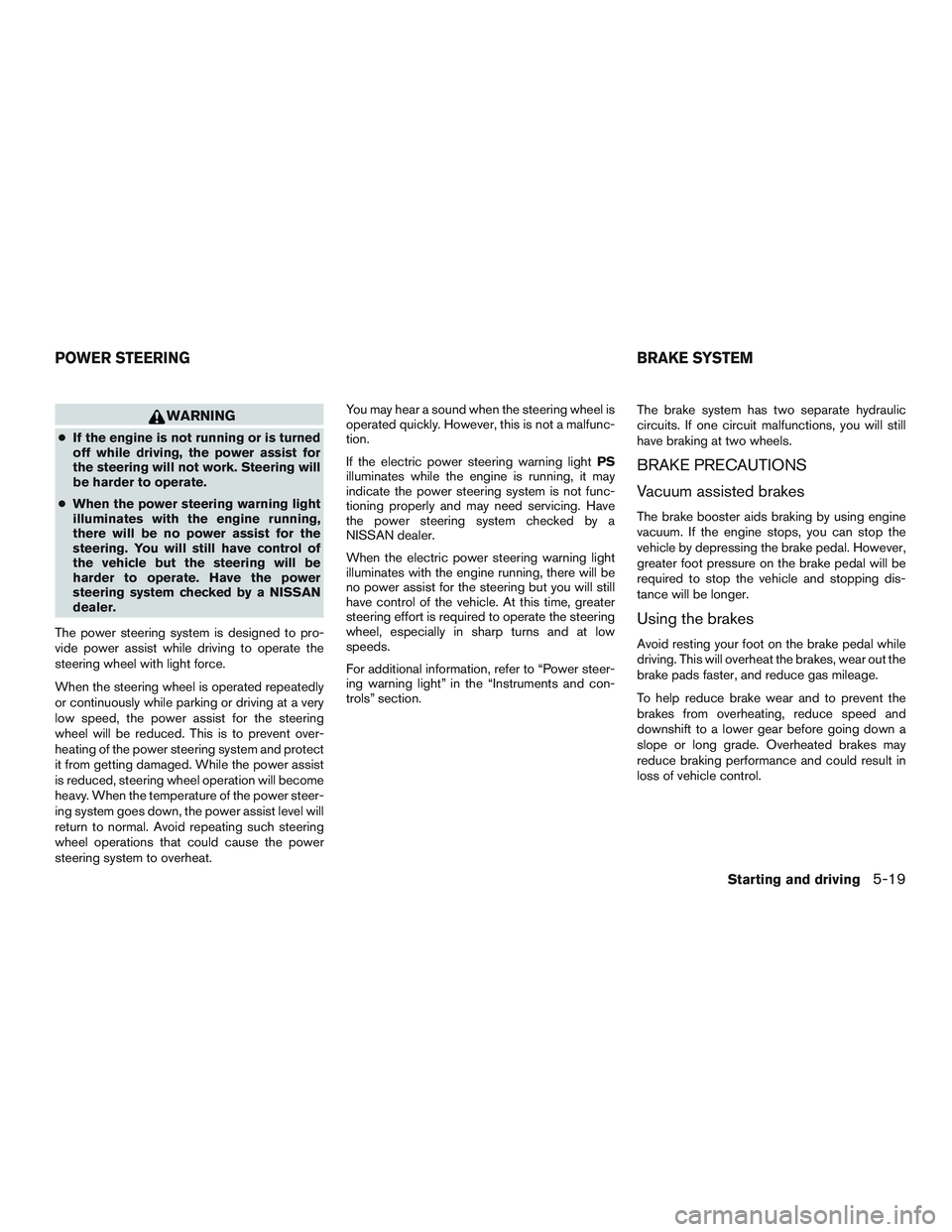2011 NISSAN MICRA start stop
[x] Cancel search: start stopPage 182 of 293

●When stopping the vehicle on an uphill
grade, do not hold the vehicle by de-
pressing the accelerator pedal. The foot
brake pedal should be depressed in this
situation.
Starting the vehicle
1. After starting the engine, fully depress the
foot brake pedal before moving the shift
lever out of the P (Park) position.
2. Keep the foot brake pedal depressed and move the shift lever to a drive position.
3. Release the parking brake, the foot brake pedal, and then gradually start the vehicle in
motion.
The automatic transmission is designed so
the foot brake pedal MUST be depressed
before shifting from P (Park) to any drive
position while the ignition switch is in the
ON position.
The shift lever cannot be moved out of P
(Park) and into any of the other gear posi-
tions if the ignition switch is turned to the
LOCK, OFF or ACC position or if the key is
removed.
Page 186 of 293

CAUTION
●Do not rest your foot on the clutch pedal
while driving. This may cause clutch
damage.
● Fully depress the clutch pedal before
shifting to help prevent transmission
damage.
● Stop your vehicle completely before
shifting into R (Reverse) .
● When the vehicle is stopped with the
engine running (for example, at a stop
light) , shift to N (Neutral) and release
the clutch pedal with the foot brake
applied.
● Do not shift to the N (Neutral) position
while driving. Doing so may result in an
accident due to loss of engine braking.
Shifting
To change gears, or when upshifting or down-
shifting, depress the clutch pedal fully, shift into
the appropriate gear, then release the clutch
slowly and smoothly.
To ensure smooth gear changes, fully depress
the clutch pedal before operating the shift lever. If
the clutch pedal is not fully depressed before the
transmission is shifted, a gear noise may be
heard. Transmission damage could occur.
Start the vehicle in the 1 (1st) position and shift to
the 2 (2nd) , 3 (3rd) , 4 (4th) and 5 (5th) gear in
sequence according to the vehicle speed. You cannot shift directly from 5th gear into R
(Reverse) . First shift into N (Neutral) , then into R
(Reverse) .
If it is difficult to move the shift lever into R
(Reverse) or 1 (1st) , shift into N (Neutral) , then
release the clutch pedal. Depress the clutch
pedal again and shift into R (Reverse) or 1 (1st) .
Suggested maximum speed in each
gear
Downshift to a lower gear if the engine is not
running smoothly, or if you need to accelerate.
Do not exceed the maximum suggested speed
(shown below) in any gear. For level road driving,
use the highest gear suggested for that speed.
Always observe posted speed limits, and drive
according to the road conditions, which will en-
sure safe operation. Do not over-rev the engine
when shifting to a lower gear as it may cause
engine damage or loss of vehicle control.
HR16DE engine model (5 M/T)
GEAR
km/h (MPH)
1st 43 (27)
2nd 79 (49)
3rd 116 (72)
4th 157 (97)
5th —
Page 192 of 293

WARNING
●If the engine is not running or is turned
off while driving, the power assist for
the steering will not work. Steering will
be harder to operate.
● When the power steering warning light
illuminates with the engine running,
there will be no power assist for the
steering. You will still have control of
the vehicle but the steering will be
harder to operate. Have the power
steering system checked by a NISSAN
dealer.
The power steering system is designed to pro-
vide power assist while driving to operate the
steering wheel with light force.
When the steering wheel is operated repeatedly
or continuously while parking or driving at a very
low speed, the power assist for the steering
wheel will be reduced. This is to prevent over-
heating of the power steering system and protect
it from getting damaged. While the power assist
is reduced, steering wheel operation will become
heavy. When the temperature of the power steer-
ing system goes down, the power assist level will
return to normal. Avoid repeating such steering
wheel operations that could cause the power
steering system to overheat. You may hear a sound when the steering wheel is
operated quickly. However, this is not a malfunc-
tion.
If the electric power steering warning light
PS
illuminates while the engine is running, it may
indicate the power steering system is not func-
tioning properly and may need servicing. Have
the power steering system checked by a
NISSAN dealer.
When the electric power steering warning light
illuminates with the engine running, there will be
no power assist for the steering but you will still
have control of the vehicle. At this time, greater
steering effort is required to operate the steering
wheel, especially in sharp turns and at low
speeds.
For additional information, refer to “Power steer-
ing warning light” in the “Instruments and con-
trols” section. The brake system has two separate hydraulic
circuits. If one circuit malfunctions, you will still
have braking at two wheels.
BRAKE PRECAUTIONS
Vacuum assisted brakes
The brake booster aids braking by using engine
vacuum. If the engine stops, you can stop the
vehicle by depressing the brake pedal. However,
greater foot pressure on the brake pedal will be
required to stop the vehicle and stopping dis-
tance will be longer.
Using the brakes
Avoid resting your foot on the brake pedal while
driving. This will overheat the brakes, wear out the
brake pads faster, and reduce gas mileage.
To help reduce brake wear and to prevent the
brakes from overheating, reduce speed and
downshift to a lower gear before going down a
slope or long grade. Overheated brakes may
reduce braking performance and could result in
loss of vehicle control.
POWER STEERING
BRAKE SYSTEM
Starting and driving5-19
Page 194 of 293

WARNING
Do not pump the brake pedal. Doing so
may result in increased stopping
distances.
Self-test feature
The ABS includes electronic sensors, electric
pumps, hydraulic solenoids and a computer. The
computer has a built-in diagnostic feature that
tests the system each time you start the engine
and move the vehicle at a low speed in forward or
reverse. When the self-test occurs, you may hear
a “clunk” noise and/or feel a pulsation in the brake
pedal. This is normal and does not indicate a
malfunction. If the computer senses a malfunc-
tion, it switches the ABS off and illuminates the
ABS warning light on the instrument panel. The
brake system then operates normally but without
anti-lock assistance.
If the ABS warning light illuminates during the
self-test or while driving, have the vehicle
checked by a NISSAN dealer.
Normal operation
The ABS operates at speeds above5-10km/h
(3 - 6 MPH) . The speed varies according to road
conditions.
When the ABS senses that one or more wheels
are close to locking up, the actuator rapidly ap-
plies and releases hydraulic pressure. This action
is similar to pumping the brakes very quickly. You
may feel a pulsation in the brake pedal and hear a
noise from under the hood or feel a vibration from
the actuator when it is operating. This is normal
and indicates that the ABS is operating properly.
However, the pulsation may indicate that road
conditions are hazardous and extra care is re-
quired while driving. The Vehicle Dynamic Control (VDC) system uses
various sensors to monitor driver inputs and ve-
hicle motion. Under certain driving conditions,
the VDC System helps to perform the following
functions:
● Controls brake pressure to reduce wheel
slip on one slipping drive wheel so power is
transferred to a non slipping drive wheel on
the same axle.
● Controls brake pressure and engine output
to reduce drive wheel slip based on vehicle
speed (traction control function) .
● Controls brake pressure at individual wheels
and engine output to help the driver maintain
control of the vehicle in the following condi-
tions:
– understeer (vehicle tends to not follow the steered path despite increased steer-
ing input)
– oversteer (vehicle tends to spin due to certain road or driving conditions)
The VDC system can help the driver to maintain
control of the vehicle, but it cannot prevent loss of
vehicle control in all driving situations.
VEHICLE DYNAMIC CONTROL (VDC)
SYSTEM
Starting and driving5-21
Page 288 of 293

Fuel-filler lid and cap............3-11
Fuel gauge ...................2-5
Fuel octane rating ...............9-5
Fuel gauge .....................2-5
Fuses.......................8-20
Fusible links ...................8-21
G
Gascap .....................3-11
Gauge Fuel gauge ...................2-5
Odometer ...................2-4
Speedometer .................2-3
Tachometer ..................2-4
Trip computer .................2-5
Trip odometer .................2-4
General maintenance ...............8-2
Glovebox.....................2-23
H
Hands-free phone system, Bluetooth® ....4-46
Hazard warning flasher switch ..........6-2
Headlight and turn signal switch ........2-17
Headlightcontrolswitch ............2-17
Headlights....................8-25
Head restraints ..................1-6
Heater Heater and air conditioner controls . .4-7, 4-15
Heater operation ............4-9,4-17
Hood release ...................3-9
Horn .......................2-20 I
Ignition switch ...................5-5
Immobilizer system ..........2-13,3-2,5-7
Important vehicle information label .......9-11
Increasing fuel economy .............5-17
Indicator lights and audible reminders
(See warning/indicator lights and audible
reminders) .....................2-7
Inside mirror ...................3-14
Instrument brightness control ..........2-18
Instrument panel ...............0-6,2-2
Instrument panel dimmer switch ........2-18
Intelligent Key system Remote keyless entry operation .......3-7
Interiorlight....................2-27
iPod® Player ...................4-42
ISOFIX child restraints .............1-20
J
Jump starting ...............6-10,8-15
K
Key.........................3-2
Key fob battery replacement ..........8-24
Keyless entry With Intelligent Key system
(See Intelligent Key system) .........3-7
Keyless entry system
(See remote keyless entry system) ........3-6 L
Labels Air conditioner specification label .....9-12
C.M.V.S.S. certification label ........9-11
Emission control information label .....9-11
Engine serial number ............9-11
Tire and Loading Information label .....9-12
Vehicle identification number (VIN) plate . .9-10
Warning labels (for SRS) ..........1-54
LATCH (Lower Anchors and Tethers for CHildren)
System ......................1-20
License plate Installing the license plate ..........9-12
Light A
irbagwarninglight.........1-55,2-10
Brake light (See stop light) .........8-29
Bulb check/instrument panel .........2-7
Bulb replacement ..............8-29
Charge warning light .............2-8
Foglights...................8-29
Headlightandturnsignalswitch......2-17
Headlight control switch ..........2-17
Headlights..................8-25
Interior light ..................2-27
Lightbulbs..................8-25
Low windshield-washer fluid warning
light.......................2-9
Passenger air bag and status light .....1-49
Security indicator light ............2-11
Warning/indicator lights and audible
reminders ...................2-7
Lock Child safety rear door lock ..........3-5
Doorlocks...................3-3
10-3